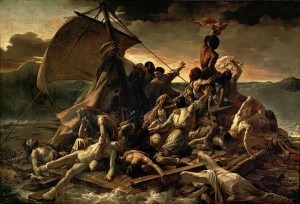
The Raft of the Medusa (Louvre, Paris)
In 1816, the French naval frigate Méduse ran aground off the coast of Mauritania. 147 people set off from the boat on a hastily constructed raft and all but 15 died before the raft was rescued 13 days later. The incompetence of the captain and the suffering of the passengers became an international scandal. The painting that the 27-year-old painter Théodore Géricault (1791–1824) created to commemorate the event launched the career of the young artist. The Raft of the Medusa (”Le Radeau de la Méduse”) was completed in 1819 and was an immediate controversial hit. It made its debut in the 1819 Paris Salon and was equally praised and condemned.
The painting shows the point in time where the last survivors are signaling to a ship at a distance. The painting is enormous (491 × 716 cm (193.3 × 282.3 in)) so that most of the figures in the painting are depicted life-size. The ship they are signaling, the Argus, rescued them purely by chance – no search had been made for the raft. Gericault met with a few of the survivors of the tragedy and they are depicted in the painting, having been painted from life.
In 1968, the German composer Hans Werner Henze wrote his oratorio Das Floss der Medusa. From its very beginning, the work courted controversy: it was intended as a requiem to the recently murdered Argentine Marxist revolutionary Che Guevara. One student hung a poster of Che on the rostrum rail but it was torn down by an official from North German Radio. While some students at the performance raised red flags for communism, other students raised black flags for anarchy and it all resulted in the chorus leaving the stage saying they wouldn’t sing under a red flag. Scuffles between the students resulted in the police being called and the entire performance was canceled. Luckily, a recording had already been made, soloists Edda Moser, Dietrich Fischer-Dieskau, Charles Régnier, several choirs and the Sinfonieorchester des Norddeutschen Rundfunks, conducted by the composer.
The Raft of the Frigate “Medusa”
The work finally received its premiere in 1971 and was staged in 1972. There are two singing roles. One is Jean-Charles, baritone, who represents man signaling with the cloth in Gericault’s painting. The second role is that of La Mort (Death), a high soprano. The narrative is told in past tense by a speaker, symbolically called Charon, after the boatman of Greek mythology who ferried the dead across the river Styx to Hades. The choral music is sung by a Chorus of the Living, a Chorus of the Dying, a Chorus of the Dead, and a Chorus of Children. One of the distinctive parts of the work occurs at the climax, where the “dead” move from the choir of the living to that of the dead, which is full of both adults and children, creating an imbalance on the stage.
As a painting, the work represents the failure of the French naval system, which is often extended as a condemnation of the newly restored French monarchy (Napoleon was defeated at Waterloo in 1815). As a work of music, the work was aligned with Henze’s commitment to left-wing politics and the red flag on stage was a step too far for many people. Each work stands for a tragedy and it’s rare to have art and music so politically aligned, especially at a 150-year separation.



